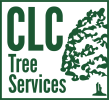Cabling and Bracing
Tree Support Systems
Sometimes trees come across challenges that have the potential to impact their health. Perhaps it has weak branches, or structural integrity issues from a storm. Leaving these issues alone could cause limb failure, putting people and property at risk.
On the other hand, tree removal is not always necessary in these scenarios. In the case of large, mature trees, which are otherwise healthy, it may be worthwhile to inspect the tree and support it by use of cabling and bracing technology. Know that CLC Tree Services uses the newest and safest in support systems.
What to Look For
- storm damage
- leaning tree
- split in the trunk of the tree
- cavities in branches
- included bark
- overall health of tree
- stability of root system
It is worthwhile to note that multi-trunked trees and trees with open canopies are often at higher risk. Trees with V-shaped crotches hold higher risk than ones with U-shapes attachments. And trees that bear heavy crops, like oaks or pecans have a higher risk of limbs failing. Ultimately though, any tree may benefit from cabling and bracing.
Cabling and Bracing Systems
Bracing systems are solid support systems to prevent movement between limbs. To install a bracing system, a hole is drilled through a tree. A rod is put in place and bolted to the tree to prevent further splits or cracks from expanding. It is more invasive than cabling systems, but provides the necessary support to compromised trees.
Cabling systems have more flexibility. They allow movement of a tree in wind, or with heavy ice or snow loads, but still offer support to jeopardized trees. With any cabling system, the placement of the cables is in the top 1/3 of a tree, in limbs strong enough to support the system. Typically, one cable is sufficient, but more can be used as necessary. Occasional inspections of installed cabling and bracing systems ensure that the support systems are intact and that their integrity remains solid. A properly installed system has an average lifespan of approximately ten to fifteen years, at which point you should consider re-installation.
There are two main kinds of cabling systems; dynamic and static.

Cabling systems provide flexible support to trees
Dynamic Cabling System
In dynamic cabling systems, a synthetic cable is strung between tree limbs to provide flexible support. A wear-resistant sock goes around the cable at the point where it wraps around the tree limbs to protect the tree from abrasion. Slack is left in the cable to allow for movement and growth. Shock absorbers are added to the cable in the dynamic system to reduce strain on already stressed trees, while still allowing movement.
Static Cabling System
In static cabling systems, a steel cable is used to provide a more secure support for your tree. Two J-lag cabling hooks and clamps are installed in the tree; one on either limb. A steel cable is strung between the two J-lags with several inches of slack between them. Excess cable is left on either end to enable crews to slacken cables as necessary as the tree grows. This provides support, but prevents too much movement and a weak crotch from splitting out.
While static cabling systems are twice the cost of dynamic systems, CLC Tree Services tends to use static systems most often. Their lower failure rates are key in this decision, but even with cabling a compromised tree is vulnerable. Because of this, we try to include fail-safes in the installation process. Ideally, during installation we try to position cables so that if a limb breaks it will swing away from nearby buildings, reducing further damage. In addition to installing cabling and bracing, CLC often prunes trees to reduce weight and stress on the tree.
If you notice excess creaking or swaying in your trees, or a significant crack or split, contact CLC Tree Services. We can inspect your tree to decide whether it might benefit from the installation of a cabling or bracing system. Extending the life of your cherished trees is part of our job, and worth it when appropriate.




You must be logged in to post a comment.